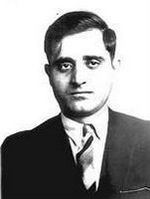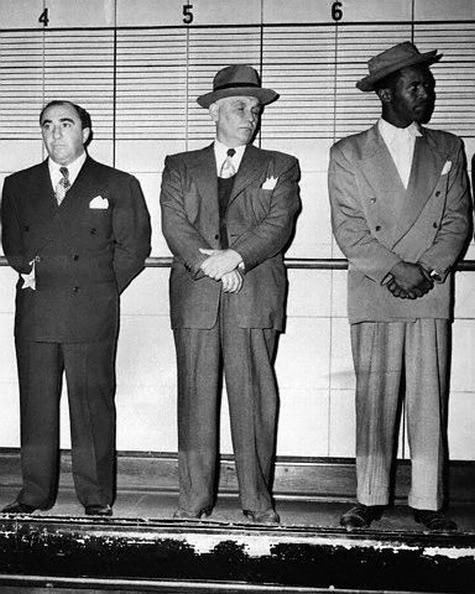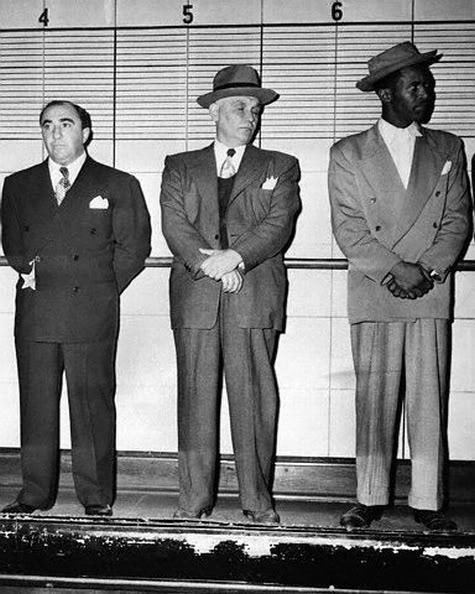Name Paul Ricca | ||
 | ||
Died October 11, 1972, Chicago, Illinois, United States Similar Tony Accardo, Frank Nitti, Sam Giancana | ||
Making of the mob chicago paul ricca
Paul Ricca, also known as The Waiter (1897 – October 11, 1972), was a Chicago mobster who served as the nominal or de facto leader of the Chicago Outfit for 40 years.
Contents
- Making of the mob chicago paul ricca
- Al capone and paul ricca
- Early life
- Joining the mob
- Working with Capone and Nitti
- Hollywood extortion case
- Extortion conviction
- Ricca and Giancana
- Later years
- References

Al capone and paul ricca
Early life

Ricca was born in Naples, Italy as Felice DeLucia. By age 17, Ricca was working for organized crime in Naples (Camorra). In 1915, Ricca stabbed Emilio Parrillo to death. Ricca later claimed that he killed Parillo for breaking an engagement to Ricca's sister. In reality Ricca killed Parrillo on Mafia orders. After serving two years in an Italian prison, Ricca then killed Vincenzo Capasso, who had testified against him in the Parillo trial, by slitting his throat.

After killing Capasso, Ricca assumed the name Paolo Maglio and fled to the United States by way of Cuba. On August 10, 1920, Ricca arrived in New York City and Americanized his name to "Paul Ricca".
Joining the mob

While in Cuba, Ricca had met Joseph "Diamond Joe" Esposito, a Chicago bootlegger and restaurant owner. After Ricca arrived in New York, Esposito brought him to Chicago. Esposito put Ricca to work smuggling whiskey from Cuba and moonshine liquor from Kentucky to Chicago. Sensing Ricca's potential, Esposito appointed him as maitre d' at the Bella Napoli, Esposito's Chicago restaurant. This job was the source of Ricca's nickname "The Waiter". The Bella Napoli was popular with many Chicago gangsters, including the leader of the South Side Gang (the precursor to the Chicago Outfit), Al Capone. Sharing several mutual friends among Neapolitan gangsters who had returned to Italy, Ricca soon gave up his restaurant job and joined the South Side Gang.
Working with Capone and Nitti
Ricca rose very quickly in the gang ranks, frequently serving as Capone's emissary to the East Coast gangs. The two soon became good friends; in 1927, Capone served as the best man at Ricca's wedding. In 1929, Capone and Ricca attended the Atlantic City Conference in Atlantic City, New Jersey, the first meeting of all the major criminal gangs in the United States. In 1930, Capone sent Ricca to New York City to serve as his emissary in peace talks aimed at ending the Castellammarese War between the New York Italian-American gangs. With the establishment of the National Crime Syndicate in 1931, Ricca's prestige and visibility continued to rise.
In 1932, Capone was convicted of tax evasion and sent to federal prison. Capone's nominal successor was Frank "The Enforcer" Nitti, with Ricca as underboss. However, according to crime historian Carl Sifakis, Ricca was the real power in the Outfit as early as 1932, and was the unchallenged de facto boss by 1939. Ricca frequently overruled Nitti's orders by saying, "We'll do it this way. Now let's hear no more about it!" In addition, the leaders of the emerging Syndicate, including Lucky Luciano, dealt only with Ricca, not Nitti.
Hollywood extortion case
In the early 1940s, Nitti convinced Ricca and the rest of the Outfit leadership to participate in a labor racketeering and extortion scheme aimed at the movie studios in Los Angeles, California. Chicago mobster Johnny Roselli ("Handsome Johnny") gained control of the Projectors Union and threatened the studios with strikes and other labor problems. To avoid labor unrest, RKO, Paramount, MGM and 20th Century Fox paid several hundred thousand dollars to the Outfit. However, two Outfit men were arrested for extortion and agreed to testify against the Outfit leadership. In March 1943, Ricca, Nitti, and other mob leaders were indicted for extortion.
On March 18, 1943, Ricca and the Outfit leadership met with Nitti. Since the movie studio racket was Nitti's idea, Ricca and the Outfit leaders demanded that Nitti plead guilty to extortion charges to save them from prison. Terrified at the prospect of prison due to his severe claustrophobia, Nitti shot himself to death the next day. Ricca now became the official boss of the Outfit with enforcement chief Tony Accardo as underboss. Ricca and Accardo would run the Outfit for the next 30 years.
Ricca was fairly soft-spoken, but was as ruthless as any crime boss. Whenever he wanted someone rubbed out, he said, "Make-a him go away." Crime historian Joe Sifakis described him as one of the most stereotypical gangsters ever produced by the Chicago Outfit.
Extortion conviction
On December 30, 1943 Ricca and his associates were convicted of extortion and sentenced to ten years each in federal prison. Ricca began his sentence at the federal penitentiary in Atlanta, but was soon lobbying to a transfer to Leavenworth Penitentiary in Kansas. The Atlanta warden, reportedly prejudiced against Italians, had severely beaten Outfit mobster Phil D'Andrea, making Ricca and the others fearful for their lives. After a series of contacts, St. Louis, Missouri lawyer Paul Dillon allegedly offered the head of the federal parole board payment to approve a transfer to Leavenworth for the Outfit mobster.
In May, 1945, against the recommendations of both wardens, Ricca and the other mobsters were moved to Leavenworth. During this period, the US Internal Revenue Service (IRS) accepted a cash settlement from Ricca for back taxes. On August 13, 1947, after a one-week deliberation, the parole board released Ricca and his co-defendants from prison on parole. However, as a condition of his parole, Ricca could have no contact with mobsters. Accardo replaced Ricca as boss. It was generally acknowledged, though, that Accardo shared power with Ricca, who stayed in the background as a senior consultant. No major transactions, and certainly no hits, took place without Ricca's knowledge.
Ricca and Giancana
As the 1950s began, Ricca started passing more of the day-to-day operation of the Outfit to Accardo. However, in 1957 Ricca suddenly told Accardo that he wanted Sam Giancana, a Ricca protégé, to take Accardo's position. Accardo was facing tax evasion charges and Ricca allegedly wanted him to disappear from public view. Although unhappy about the demotion, Accardo accepted it, joining Ricca in semi-retirement. However, it was understood that Giancana had to get Accardo and Ricca's approval for all major transactions, particularly hits. By staying in the background, Ricca and Accardo avoided further imprisonment far longer than Capone had.
As Ricca aged, Accardo began to make more of the high level decisions, ultimately pushing Giancana out in favor of Sam Battaglia in 1966.
Later years
In 1957, the federal government charged Ricca with illegally entering the United States under the alias "Paul Maglio". Three years earlier, the government had located the real Paul Maglio in Chicago and now brought him to testify against Ricca. Although the government won a deportation order, it was later overturned.
In 1959, Ricca was convicted of tax evasion and sentenced to nine years in federal prison. After serving 27 months of his sentence, Ricca was released. In 1965, Ricca was again indicted for tax evasion. In court, Ricca maintained that his total income for 1963, $80,159, was earned at the race track. Ricca was eventually acquitted.
Ricca died of a heart attack on October 11, 1972. He is buried at Queen of Heaven Cemetery in Hillside, Illinois
